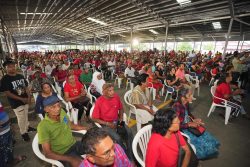 He’s widely known as ‘Reds’ Perreira but his passport name is Joseph, named after his grandfather Joseph Francis Martins, who, in later life, was my father after he married a second time. That makes Reds and me some kind of family – step cousin? – but I’m not sure exactly what. The families from Joseph’s two wives weren’t particularly close, but Reds and I gravitated to each other probably because we had become known in our fields – he in broadcasting, I in music – and over the years a brotherly connection grew; we’re constantly in touch by email or phone. Reds is full of information and opinions on sport, particularly cricket, and when he came to Guyana recently for a sports tourism seminar hosted by the Ministry of Tourism, I began chatting with him about his career. The name ‘Reds’ by the way, came not from the usual ‘red man’ label Guyanese use for a mixed-race person, but because as a young man he actually had red hair. Early on, his broadcasting genes were present. As he put it, “My interest simply came through the power of radio. As early as 1948 at 11 years of age, I remember listening to Test cricket when England toured the West Indies, which was followed by the 1950 tour of England with the Three W’s and Ram and Val. Listening to that as a youngster I just loved the theatre that came through the radio, with the description of the bowler coming in, the batsman responding and the reaction of the crowd. However, although my interest was great for the game and for commentary, I had no thoughts of ever getting to the stage of becoming a professional commentator, as I was fighting an uphill battle with a major stammering problem.”
He’s widely known as ‘Reds’ Perreira but his passport name is Joseph, named after his grandfather Joseph Francis Martins, who, in later life, was my father after he married a second time. That makes Reds and me some kind of family – step cousin? – but I’m not sure exactly what. The families from Joseph’s two wives weren’t particularly close, but Reds and I gravitated to each other probably because we had become known in our fields – he in broadcasting, I in music – and over the years a brotherly connection grew; we’re constantly in touch by email or phone. Reds is full of information and opinions on sport, particularly cricket, and when he came to Guyana recently for a sports tourism seminar hosted by the Ministry of Tourism, I began chatting with him about his career. The name ‘Reds’ by the way, came not from the usual ‘red man’ label Guyanese use for a mixed-race person, but because as a young man he actually had red hair. Early on, his broadcasting genes were present. As he put it, “My interest simply came through the power of radio. As early as 1948 at 11 years of age, I remember listening to Test cricket when England toured the West Indies, which was followed by the 1950 tour of England with the Three W’s and Ram and Val. Listening to that as a youngster I just loved the theatre that came through the radio, with the description of the bowler coming in, the batsman responding and the reaction of the crowd. However, although my interest was great for the game and for commentary, I had no thoughts of ever getting to the stage of becoming a professional commentator, as I was fighting an uphill battle with a major stammering problem.”
Discipline is part of Perreira’s world, however, so he overcame the stammering and started doing radio commentary in Guyana. Under the guidance of stalwarts such as Hugh Cholmondeley, Rafiq Khan, Terry Holder and Ron Sanders he would become one of the top cricket broadcasters in the Caribbean, going on tour with the West Indies team in its heyday. His memories of the time are vivid. “Seeing Roy Fredericks’ 169 against Australia at Perth was a gem. He produced one of the best innings ever seen in Australia of 169 from 145 balls with his 100 coming from 71 balls; he hit twenty-seven 4’s and one 6, taking apart the Australian fast attack of Lillee, Thompson, Gilmore and Walker. I remember the batting of Clive Lloyd and Rohan Kanhai, a feature of the WI World Cup victory in 1975. They came together at 50 for 3 after Greenidge, Fredericks and Kallicharran were all dismissed. They put on a combination of power hitting by Lloyd and the subtle skill of Kanhai in a partnership of 149 with Lloyd scoring 102, off 108 balls, including twelve 4’s and two 6’s.
“Brian Lara’s 277 for the WI at the Sydney cricket ground in 1993 can only be described as a master class by this young developing Caribbean star. In the previous Test match Shane Warne had scuttled the WI out with a spell of 7 for 52, but Lara, on this occasion, took heavy toll on the great Australian leg-spinner, when he reduced him to 1-116 off 41 overs. In Lara’s 277, he hit 38 fours, in 474 minutes of batting. In Perth, in the same 1992/93 series, Curtly Ambrose produced an astounding bowling spell to reduce Australia to 119 all out on the opening day. His overall figures were 7 for 25 and at one stage he had the unbelievable figures of 7-1; this outstanding feat helped the WI to not only to win the Test, but the series.” Asked to pick our greats, he says: “Beyond any doubt Sir Garfield Sobers was by far the best batsman during my career. In 91 Test matches, he scored over 8000 runs at an average of 57, and was outstanding as a batsman for Barbados, South Australia and the Rest of the World Eleven. Malcolm Marshall was easily the most outstanding and skilful fast bowler during my career. He was quickly able to figure out any batsman, had the ability to bowl over and around the wicket, and in a given over, would produce almost six different deliveries. Lance Gibbs was easily the best spinner of my time. He did not need turning wickets to propel him to 309 Test wickets in his career, as the majority of his victims were on hard plumb batting tracks. His cleverness was in flight and his ability to impart spin. When it comes to fieldsmen, I have to name Roger Harper. Gifted with height, and a sure pair of hands, he was extremely athletic and capable of fielding anywhere. Long will I remember his catching of Ian Botham at Lords in an ODI match off Eldine Baptiste, sprinting in from square leg, as well as a stunning run-out of Graham Gooch at Lord’s for the Rest of the World, off his own bowling.”
Reds’ career veered away from a cricket focus to sport generally when he was selected to head up the OECS Sports Desk in September 1984. He says: “My cricket background played an important role in my appointment as it had taken me to all the member islands for a number of years. During my 12 years at the OECS sports desk I had to deal with sponsorship, rearranging of events, interacting with media and gaining firm knowledge of which events can attract competitors for a sports tourism event. It was a great expansion for me; I learned a lot about the business of sport.”
That experience has contributed to the Pomeroon native’s development as a sports consultant, as in his recent involvement in Guyana. “I see great potential for the expansion of sport here and the ingredient of sports tourism. There is a need for a National Sports Commission, but it’s important that it not be made up of sports association members, because of the potential conflict of interest. Fundamentally, Physical Education should be taught at UG as a subject to meet the needs of Guyana. A National Racing Commission should be established without any track owners or horse owners on it, and Guyana generally needs the establishment of sports clubs for stronger associations through a collaboration programme of the associations, Ministry of Sport, and the national Olympic Association. We need better infrastructure for cycling and hockey, subject to funds, and the sport potential of the neighbourhood democratic councils needs to be examined by sports associations. It is also vital for us to continue to develop the cutting edge coaching programmes which can lead to higher certification. Eventually, we need something similar to Jamaica’s G C Foster College of Physical Education and Sport which provides athletic coaches for every school in that country – it’s at the heart of their track-and-field achievements.”
In his chosen field, Reds is a sterling contributor. We have many examples like him in the Caribbean; they stand out in their specialty and we don’t shout enough about them. Never having abandoned his Pomeroon roots, the grandson of Joseph Martins has made a wide contribution to our region. He talks about his close Barbadian friend, the late Tony Cozier, also a cricket broadcaster, as one of those stand-outs. Reds Perreira himself is on that list.










